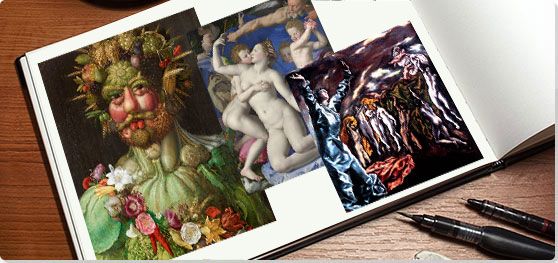Summary of Mannerism
Mannerism launched a highly imaginative period in art following the climax of perfection that naturalistic painting had reached in Renaissance Italy. Artists in 16th century Florence and Rome started to veer from classical influences and move toward a more intellectual and expressive approach. This ushered in a veer from authentic portrayals of figures and subjects, a rejection of harmony, and the development of a dramatic new style unconfined by the pictorial plane, reality, or literal correctness. Radical asymmetry, artifice, and the decorative also informed this movement. New discoveries in science had led society away from Humanist ideals and paintings no longer posited man as the center of the universe, but rather as isolated, peripheral participants in the great mysteries of life.
Some scholars further divide Mannerism into two periods. Early Mannerism, which expressed an anti-traditional approach and lasted until 1535, was followed by High Mannerism where a more intricate and artificial style appealed to more sophisticated patrons, becoming a kind of court style. Later, the use of the term Mannerism to denote a particular period of art history was pioneered by Luigi Lanzi, a 17th century art historian and archeologist. The period would become a forebear to the Baroque period.
Key Ideas & Accomplishments
- A key element of Mannerism was the use of figurative serpentinata, or "serpentine figure" in depicting human bodies. With extended limbs, elongated forms, and a fluid S-shaped grace, these figures presented an otherworldliness that departed from classical renditions.
- Many Mannerist works presented individuals or scenes in non-naturalistic settings, oftentimes without any contextual basis, inviting the viewer into a more philosophical experience rather than a literal reading of the work.
- Mannerism's reach was wide, with many important schools that cropped up to experiment within this new form. Yet, while each school drew upon its own indigenous attachments and cultural lore, the styles of presentation remained largely the same.
- Subjects and themes of Mannerism furthered the Venetian School's genres and expounded upon them. Mythological and allegorical subjects with an erotic theme, architecture, landscapes, and pastorals were common motifs albeit evolved via the new morphed aesthetics.
Artworks and Artists of Mannerism
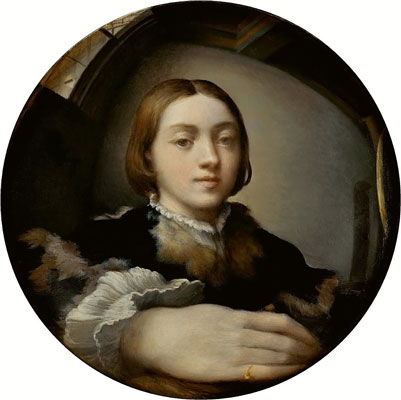
Self-Portrait in a Convex Mirror
This iconic self-portrait shows the artist, aged twenty-one, reflected as he looks into what appears to be a mirror. His distorted hand, extenuated, fills the lower part of the image, inviting the viewer in to the intimate scene. Beautiful, almost angelic, his gaze is introspective and focused with a still intensity. The fabrics of his clothing, the multicolored patches of expensive fur, the lacy frill of his sleeve, and the white of his neckline are rendered with a subtle play of light that seems precise though the brushstrokes are almost impressionistic.
The artist intended this as a tour de force, as it was one of the paintings he took with him to Rome when seeking the patronage of Pope Clement VII. The work was remarkably innovative, as he painted the image on a convex panel. Supposedly he had a carpenter make a wooden ball that was then sawed in half, so that the work would resemble a barber's mirror. Most Renaissance artists regarded the mirror as a tool for observation and normalized images painted from reflections. But Parmigianino kept the distortions in order to create a complex play upon the nature of perception itself.
The self-reflexivity in the work was remarkably modern. Art critic Michael Glover wrote, the result is "one of the most inscrutable portraits in the entire Western canon." Additionally, art historians David G. Stork and Yasuo Furuichi stated, his "interest in psychological introspection, belief in a shifting impermanent visual reality, experimentation in the dark sciences of alchemy, wit, and youthful desire to demonstrate his artistic prowess all find their expression."
Parmigianino became one of the most influential of the Mannerists, even though he died at the age of thirty-seven. His influence extended to print making and he has been called the "father of etching." John Ashbery, the American poet and critic, wrote his book length poem Self-Portrait in a Convex Mirror (1975), inspired by this piece.
Oil on convex panel - Kunsthistorisches Museum, Vienna
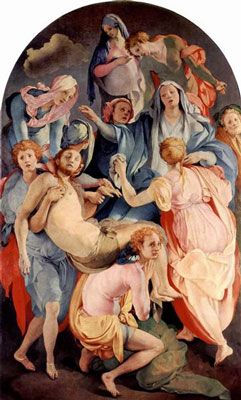
Deposition from the Cross
This altarpiece depicts a swirl of stricken and grieving figures as they lower the dead body of Christ, his pale elongated torso depicted in a serpentine curve that extends through the lower center of the work. The Virgin Mary, dressed in blue, faints in the upper right. Though the work is thought to be the deposition from the cross, the artist has innovatively left out the cross, and has also added a number of figures, including the man whose face glimpsed at the far right, thought to be a self-portrait of the artist. Because the painting's composition emphasizes the swirling gestures of figures and robes, each face is like a still point of isolation, its white shocked expression echoing the face of the dead Christ.
This work marked the arrival of the Mannerist style with its unusual color palette, its elongated figures in distorted poses, and its creation of an unrealistic pictorial space. Pontormo's influence was, perhaps, greatest upon Bronzino, though he also influenced Vasari and El Greco, as well as other lesser-known artists of the time like Morandini, Naldini, and Salviati.
Oil on canvas - Church of Santa Felicita, Florence
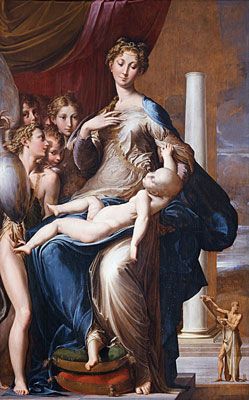
Madonna with the Long Neck
This work focuses on the Madonna, whose extenuated limbs and monumental scale fill the center of the canvas. A nude infant Jesus reclines on his mother's lap while angels crowd around them. His pale form, limp arms, and closed eyes create a disconcerting effect reminiscent of a woeful Pietà. Mary's expression is also nontraditional. As she holds elegant but overly long fingers to her heart, looking down with a slight smile, she seems bemused and distanced. A dissonance results between the haunting religious image and its portrait of what could be a fashionable but emotionally disconnected aristocrat. The angels are much more animated, but evoke the curiosity and liveliness of ordinary children more than a divine presence. The architectural setting, while conveying a 'classical' effect, is not classically rendered with linear perspective, and an unsettling ambiguity results. To the right of the column, the very small figure of St. Jerome, his limbs elongated, holds out a scroll while looking back over his shoulder.
The work was popularly titled "Madonna with the Long Neck," as Mary's graceful linearity evokes a swan. In 1534 this work was commissioned for Francesco Tagliaferri's funerary chapel in Parma but left incomplete in 1540 when the artist died. Perhaps, no other work has so come to characterize the Mannerist approach, as the artist pulled out all the stops in creating an unorthodox treatment of space and the figure. As E. H. Gombrich wrote, "Instead of distributing his figures in equal pairs on both sides of the Madonna, he crammed a jostling crowd of angels into a narrow corner, and left the other side wide open to show the tall figure of the prophet, so reduced in size through the distance that he hardly reaches the Madonna's knee. There can be no doubt, then, that if this be madness there is method in it." The Madonna's right foot seems to extend beyond the pictorial plane, as if into the viewer's space, and suggest that the artist's intent was to innovatively involve the viewer in its riddle of relationship and meaning.
Oil on wood - The Uffizi Gallery, Florence
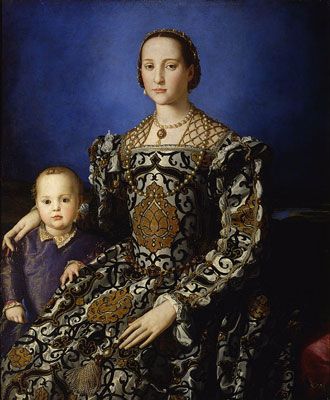
Eleanor of Toledo
This portrait shows Eleanor of Toledo, the Spanish wife of Cosimo I de' Medici, then the Grand Duke of Tuscany, and one of their sons on her right. Scholars debate which of the couple's three sons is depicted, though most hold that, according to the painting's date, it must be their middle son, Giovanni. Eleanor's hand rests on her son's shoulder, and the gesture, combined with her wearing a dress with a pomegranate motif symbolizing motherhood, refers to her role as a kind of secular Madonna.
This portrait was part of a pair, the other being Bronzino's portrait of Cosimo I. The painting was intended to be an idealized portrait, reflecting the stability of the ruler, the wealth and dignity of his family, but the overall effect is of an inscrutable distance, as the artist, a noted poet, wrote, "steel inside and ice without." Eleanor's expression is unreadable, her appearance, a mask creating an impenetrable social presence. As art critic James Hall noted, in the work, "Naturalism is reined in by quasi-heraldic colors, contours, patterns and shapes. His power-dressed women both seduce and awe."
A great deal of emphasis is given to the expensive silk dress, brocaded with black arabesques and gold weft loops, leading some critics to argue that the work was also, in effect, a pioneering use of product placement, advocating for the Florentine silk industry which Cosimo I had revived. Art critic Roderick Conway Morris wrote, "Most famous is the majestic, Madonna-like picture of Cosimo's consort, Eleonora of Toledo, in which her gorgeous, minutely observed brocade dress, in monetary terms worth scores of paintings, is as much a protagonist as the Duchess herself."
The portrait influenced 20th century artists, as seen in Frida Kahlo's Portrait of Alicia Galant (1927).
Oil on panel - The Uffizi Gallery, Florence
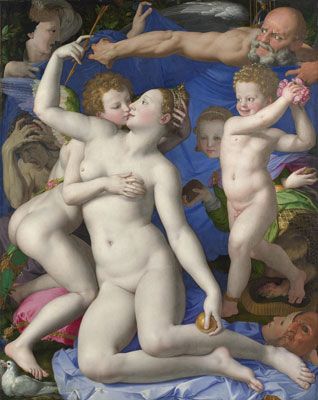
An Allegory with Venus and Cupid
This allegorical but mysterious painting depicts Venus in the center, her pose contorted to turn her alabaster-smooth torso toward the viewer. A nude Cupid, who is her son from an adulterous affair with Mars, embraces her as his right hand caresses her breast and his left turns her head toward him for a kiss. Cupid universally represents desire, and the artist has shockingly depicted the two as lovers, though the work also seems like a theatrical staging with its two masks, similar to those symbolizing tragedy and comedy, lying discarded on the lower right. Adding to the mystery, to Cupid's left a grimacing haggard figure clutches her head, while, above, a face floats in profile, her hands unfolding the blue swirling cloth of the background. On the right holding a bouquet of bright pink flowers in his uplifted hands, a gleeful putto strides forward. Behind him a chimera combining a girl's face with a disjointed body that seems part animal and part bird, a scorpion's barb on her back, holds out a honeycomb. The meaning of the figures has been much debated, as some scholars identify the chimera with Pleasure and Fraud, the figure on the left tearing its hair with Jealousy, and the putto as Folly. The wrathful man whose head looms at the top right, his arm reaching out as if to tear away the veiling blue cloth, while an hour glass can be seen behind him, seems to be Time. The work presents an erotic riddle, implicating the viewer.
It's thought that Cosimo I commissioned the work to be presented to King Francis I of France. It was intended to appeal to the erotic tastes of the court and Bronzino succeeded through his cold stylization of Venus as a precious alabaster statue, while the luxurious fabrics and the discarded masks, evoke the many carnivals of the time, creating an aristocratic environment, which was part of the work's allure.
Later critics like John Ruskin and Bernard Berenson specifically condemned the work for its artificiality and perversion. However, artists like Jacques-Louis David, Pablo Picasso, Henri Matisse, and Giorgio de Chirico, were later inspired by "the master of the mannerist erotic scene," as Morris described Bronzino. The painting has also been a cultural presence, referenced in novels by Iris Murdoch and Robertson Davies, in Yasuko Aoike's manga From Eroica with Love (1976-2010), and Lina Wertmüller's film Seven Beauties (1975).
Oil on wood - The National Gallery, London
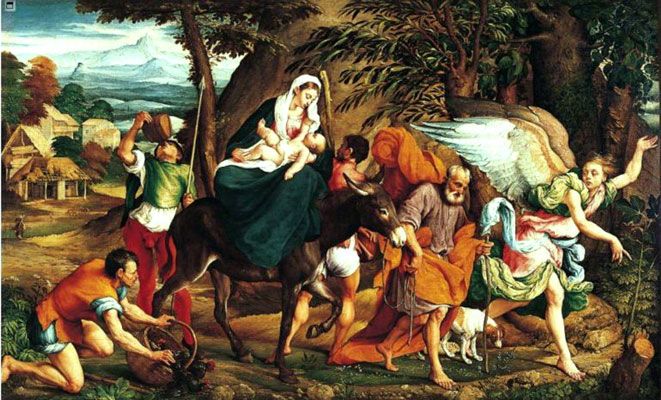
The Flight into Egypt
This animated scene depicts the Holy Family being led by an angel into Egypt. The Madonna riding upon a donkey and holding the infant Jesus is central, as her face encircled with white forms the apex of a pyramid. Joseph walks ahead, orange robes billowing around him. The composition's left to right diagonal emphasizes the dynamic movement of their flight. The angel's right hand points downward to a newly sprouting tree, a symbol of the resurrection, while his left hand turns upward as if to convey heaven's guidance. At the same time, the idiosyncratic depiction of the angel in contrast to the more earthy treatments of the other figures emphasizes his otherworldly presence.
Bassano was born in Bassano del Grappa, a small village where his father, also an artist, had a small workshop. Nonetheless, the young artist was aware of the Venetian art of his day, and his work was influenced by Titian's color palette, as well as the prints of Albrecht Dürer. As art critic Roderick Conway Morris wrote, his "increasingly distinctive style [was] born of a complex mix of absorption and innovation...yet he was content to remain in his birthplace, thus preserving a degree of isolation...that allowed his originality to flourish."
Bassano was a pioneer of genre scenes, specifically with Biblical pastorals like this one that included elements of contemporary settings. His picturesque and original style made him one of the most popular and influential of Venetian painters in the mid-1500s. His work was, subsequently, overshadowed, in part due to a proliferation of mediocre copies of his work following his death, but was recently revived with major exhibitions in 2010.
Oil on canvas - Norton Simon Museum, Pasadena, California
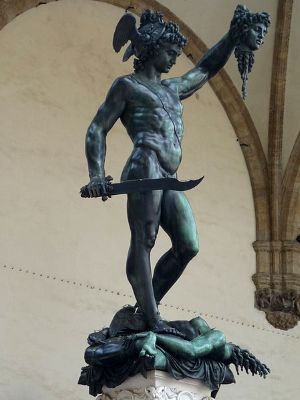
Perseus with the Head of Medusa
This bronze statue shows the Greek mythological hero Perseus, as he holds up the head of Medusa in a gesture of victory, while standing upon her contorted and collapsed body. The overall effect is one of powerful domination and emotional ferocity conveyed eloquently through Perseus's facial expression.
Cosimo I commissioned this work to make a political statement, as Perseus symbolized the Medici domination of Florence. Placed within the central piazza, the work was meant as part of a narrative display of artworks, symbolizing the history of the Medici, which also included Michelangelo's David (1501-1504), Bandinelli's Hercules and Cacus (1525-1534), and Donatello's Judith and Holofernes (1455-1460). Cellini's statue was the first casting of a monumental bronze in fifty years and the first statue since antiquity to have a figurative sculpture forming part of the base. These innovations thus indicated a new era of artistic mastery, and another testament to the power of the ruling family.
The statue has been greatly influential as Antonio Canova and the 18th century Russian sculptor Feodosy Fyodorovich Shchedrin made their own versions of Perseus. The Surrealist Salvador Dalí cast a number of sculptures referencing Cellini's statue, from small works created in series, to large statues like the one displayed on the Avenida del Mar in Marbella, Spain.
Bronze - Loggia dei Lanzi, Florence
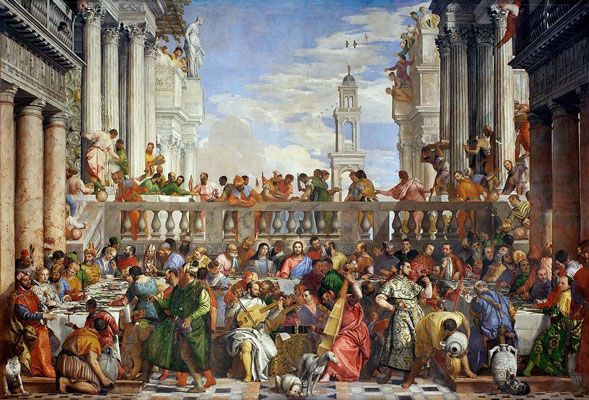
The Wedding Feast at Cana
This vibrant and monumental painting depicts the Wedding Feast at Cana where Christ, pictured in the lower center, a halo illuminating his head, performed his first miracle, changing water into wine, after his mother informed him the crowd had run out of wine. The Biblical account leaves out any information about the identity of the couple married at Cana and emphasizes only the miracle at his mother's request. As a result, the event became associated with the beginning of his public ministry, and depictions emphasized the encounter between the sacred miracle of Christ and the profane world. Therefore, here, a teaming crowd is depicted, containing many noted portraits as the group of musicians seated in the lower center are the artists Jacopo Bassano, with the flute, Titian with the violin, Tintoretto with the viola, and Pietro Aretino, a noted poet, standing next to Titian. The guests include most of the era's monarchs including Francis I of France, Suleiman the Magnificent of the Ottoman Empire, and the Holy Roman Emperor Charles V. As a result, the work is a vivid portrayal of its time, while simultaneously capturing the feel of a dynamic and festive occasion.
The work was commissioned by the Black Monks of the Order of Saint Benedict for their monastery's refectory, designed by the noted architect Andrea Palladio. The large format with its almost life-sized figures was meant for viewing from below, making the painting's feast a trompe l'oeil extension of the monks' dining area. Stylistically, the ambitious work combines many elements signature to the time. This includes Venetian colorito, emphasizing a vivid color palette, Florentine line, notable in its architectural perspective, and a Mannerist interest in dynamic movement, juxtaposed narratives, and extreme foreshortening in the highly varied poses of the figures. Veronese's ability to seamlessly weave together these elements made his work innovative among the Mannerists, as did his sophisticated sense of composition and vivid contemporaneity.
The inclusion of so much imagery of secular life made the work somewhat scandalous to the public of its time, but Vasari quickly acclaimed Veronese's work. As art critic Laura Cumming wrote, "what is so astonishing is the coherence of his art. There can be 10, 20, sometimes 30 people on the ground level of a Veronese, and then a scattered audience of onlookers staring down from steps and balconies, yet every inch of what ought to bewilderingly diverse is equally strong, equally clear and significant."
Veronese has continued to influence modern culture, as the novelist Henry James wrote, "Never did an artist take a greater delight in life, seeing it all as a kind of breezy festival." In 2009 Peter Greenaway created a multimedia "vision" of this work at the Venice Biennale in his series "Nine Classic Paintings Revisited."
Oil on canvas - Musée du Louvre, Paris
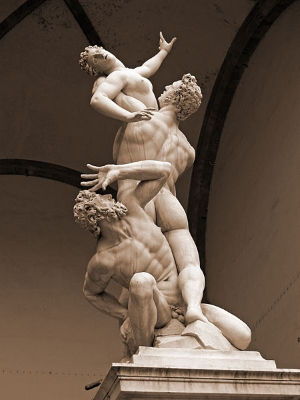
Rape of the Sabine Women
This famous and influential Mannerist sculpture depicts the violent struggle between three nude figures: a Roman man, his veined back denoting his strength, a nude woman who he seizes as she twists backward, trying to escape, and an older man crouching beneath the Roman in fear. For all its classical treatment that combines a refined finish with anatomical naturalism, the work powerfully conveys sexual aggression through its Mannerist emphasis on the figura serpentinata and expression of terror and helplessness.
The figures create a spiraling vortex with the result that the perspective of the work changes continually as the viewer walks around it. This multiplicity of view, lacking one central frontal view, was a radical innovation.
In 1579 Francesco I, the son of Cosimo I de' Medici, gave Giambologna a large marble block to sculpt a work with a complex group of figures. The sculptor originally intended to create two figures but, subsequently, added a third. The title of the work, only assigned later upon installation in the Loggia dei Lanzi, depicts a mythological account from Roman history when the Romans, then new arrivals in Italy, sought wives from the native Sabine tribes. The Sabines refused, so the Romans staged a festival to honor the god Neptune and invited the tribe in order to abduct the women.
Like the artist's Hercules Beating the Centaur Nessus (1599), which depicts the Greek hero beating the centaur who attempted to rape his wife, this work's violent encounter reflected the deep uncertainty of the times, as sexual violence was extensive in the era's many wars. The dramatic intensity and technological innovation of the piece - its complex treatment of three figures within a single block of marble - had a great influence on subsequent artists, most particularly, Bernini, the leader of the Baroque period, as seen in his The Rape of Proserpina (1621-1622).
Marble - Gallery of the Academy of Florence
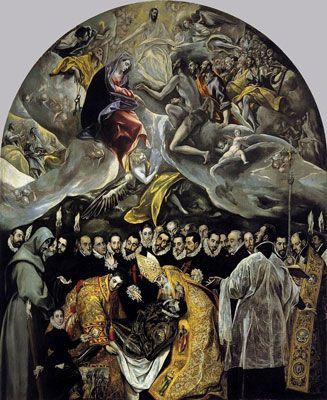
The Burial of the Count of Orgaz
This iconic work depicts the burial of the Count of Orgaz, revered in Toledo for his piety and the miracle that attended his death as Saint Stephen and Saint Augustine appeared to bury him and take his spirit to heaven. The work is divided into two realms, the heavens where Christ forms the apex of a pyramid with Mary on the left and St. John the Baptist on the right, and the terrestrial funeral of the lower plane. Dynamic movement results from the contrast between the dark horizontal line of men, all dressed in black, white collars emphasizing their faces, and the swirling verticals of the clouds and heavenly figures, echoed in the gold and red robes of the two saints in the foreground. Bending over as they hold the body of the dead count, his dark armor reflecting the light, the forms of the two saints resemble the curvilinear and enveloping clouds, which are otherworldly, diaphanous membranes.
Andrés Núñez, the priest of El Greco's parish church Santo Tomé, commissioned the work as part of a renovation project of Orgaz's burial chapel. The work is a notable masterpiece of Mannerist portraiture, portraying Núñez, King Phillip II of Spain, a self-portrait of the artist, and a portrait of his son, Jorge Manuel, as well as noted scholars and clergy. However, what matters here is the spiritual gathering, as many of those depicted were those who honored the Count of Orgaz's piety.
El Greco's innovation in Mannerism was to infuse the style with spirituality, creating images that became deeply emblematic interior visions. As a result the work takes on the quality of an unseen vision, perceived by the viewer and only a few among the gathering. The artist's innovative omission of any sense of setting - depicting no horizon or ground or sense of perspective - locates us within the vision itself.
His unique style synthesized the Byzantine tradition in which he was first trained in his native Greece and the Venetian colorito of Titian's workshop where he later worked. As art historian M. Lambraki-Plaka wrote of the work, "El Greco sets before us, in a highly compressed form the wisdom he has brought to his art, his knowledge, his expertise, his composite imagination and his expressive power. It is the living encyclopedia of his art without ceasing to be a masterpiece with organic continuity and entelechy."
Of all the Mannerists, El Greco had the greatest influence on modern art, as Eugène Delacroix, Édouard Manet, and Paul Cézanne rediscovered his work in the 1800's. His work influenced the development of Expressionism, and, most notably, was a singular influence upon Pablo Picasso and the development of Cubism.
Oil on canvas - Iglesia de Santo Tomé, Toledo, Spain
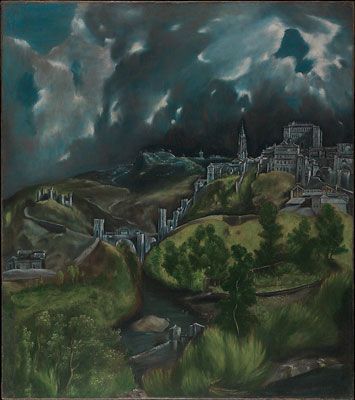
View of Toledo
This masterful landscape depicts a view of Toledo, with the Tagus River flowing from the lower right up through the center of the work, where its serpentine curve is echoed by the green curves of the surrounding hills. The Alcántara Bridge intersects the low center, connecting the Castle of San Servando on the left, with the city's line of diagonal buildings that ascend on the right, its towers and spires outlined by a stormy sky, its grey clouds opening to patches of white and deep blue. Rather than depicting the city naturalistically, the artist has reconfigured the city, moving a few buildings to create a kind of emblematic view. The rhythmic curvilinear forms and interplay of glowing dark greens, contrasting with the nearly black horizon, the illuminated grey of the buildings and the white edges of cloud, create a sense of a living landscape, pulsing with a somber mysticism. Almost imperceptibly the landscape is populated. Monks gather in front of the monastery on the left below center. A man on horseback crosses the river, as along the bank three men are spear fishing and a number of people are gathered on the shore. These figures are rendered precisely, sometimes with a single brushstroke, but in terms of their cyclical activity rather than their individuality, conveying human presence as simply part of the landscape itself.
At the time he painted this work, the Counter Reformation in 1563 at the Council of Trent had confined art for religious subjects and purposes and banned landscape painting. In defying the ban, El Greco pioneered Spanish landscape painting, but also demonstrated that deep spirituality could be expressed in the genre. The dark brooding of the impending storm both shadows and illuminates the landscape, as if this city where El Greco settled and did much of his work was under a dark forbidding divine wrath. Diego Rivera, Ignacio Zuloaga, David Bomberg, Chaïm Soutine, and André Masson, all painted landscapes referencing this work, as seen in Masson's Emblematic View of Toledo (1942).
Oil on canvas - Metropolitan Museum, New York
Beginnings of Mannerism
The development of Mannerism began in Florence and Rome around 1520, reflecting a "perfect storm" of circumstances affecting the art world at the time. Printmaking had allowed for the spread of popular imagery by artists such as Michelangelo and Albrecht Dürer to infiltrate the collective consciousness in Italy (and the Northern countries), positing artists as divine creators rather than just employees of wealthy patrons and churches. In 1517, Martin Luther's Wittenberg Theses (1517), which denounced church practices and called for reform, launched the Protestant Reformation. Because of this, the serene and classical idealizations of beauty characteristic of the High Renaissance no longer seemed tenable.
At the same time, young artists felt that the style of Raphael and Leonardo was so perfected that no further development or expression of individuality was possible.
Also, scientific discovery, including the discovery of the New World, and Copernicus establishing that the sun, not the earth as had been commonly believed, was the center of the solar system, challenged the Humanist belief that man was the center of the universe.
This caused a sense of alienation and disconnection that was conveyed in Mannerist treatments, as even figures reacting with intense emotion seemed isolated from one another. Rather than creating harmonious compositions depicting realistic space, artists began to explore the possibility of situating the image within an intellectual space. As a result, the treatment of space and the figure became less rational, compressing a number of figures into one flattened plane, creating bizarre or complex architectural settings, the frame and the picture blurring into one decorative effect.
Laocoön and His Sons
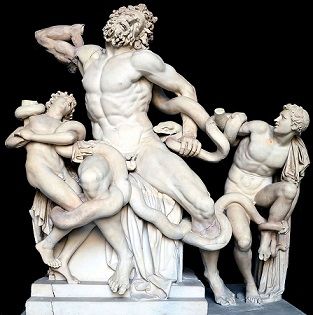
An important precursor to Mannerism was the influence of the Classical Roman statue Laocoön and His Sons (40-30 B.C.E.), found in Rome in 1506 during extensive reconstructions. The statue dramatically depicted the moment when the gods sent giant serpents to kill the prophet and his two sons for trying to warn their fellow Trojans against bringing the Greek wooden horse into the city. The statue offered a new look at classical art, embodying the Hellenistic style with its emphasis on dramatic movement and intense emotion, rather than an idealized harmony previously associated with the Greeks and Romans. It's thought that the figurative serpentinata, or "serpentine figure," that became a noted element of Mannerism was drawn from the struggling forms of this masterpiece.
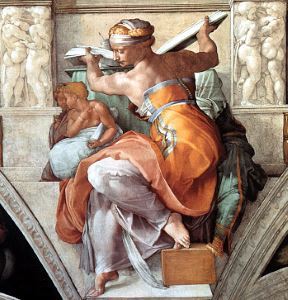
Laocoön and His Sons attracted the attention of the leading Renaissance artists and patrons. Pope Julius II, the most powerful patron of the era and a noted collector of classical works, sent Michelangelo to oversee the statue's recovery. Its influence on the artist can be seen in both his sculptures such as Dying Slave (1513-1516) as well as his painting of various figures in the Sistine Chapel ceiling (1508-1512), as he turned toward a Mannerist treatment. The Laocoön also influenced other High Renaissance artists, as Raphael used Laocoön's face in his Parnassus fresco (1509-1511) and Titian echoed the struggling figures in his Averoldi Polyptych (1520-1522).
Rosso Fiorentino and Jacopo da Pontormo
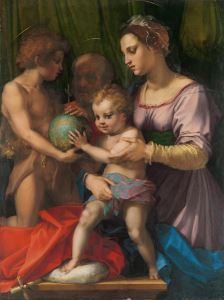
Two Florentine artists, Giovanni Battista di Jacopo, known as Rosso Fiorentino or Il Rosso, and Jacopo da Pontormo pioneered Mannerism. Both were trained in the workshop of Andrea del Sarto, who employed High Renaissance principles while adopting an increasingly vivid color palette and a wide variety of figurative poses. His adaptations influenced both Pontormo and Rosso's development of an artistic style that rejected the classical treatment of space and the human figure.
In addition, both Michelangelo and Albrecht Dürer influenced Pontormo. Pontormo found Dürer's emphasis on intense emotion while employing a crowded field of figures sympathetic to his own artistic aims.
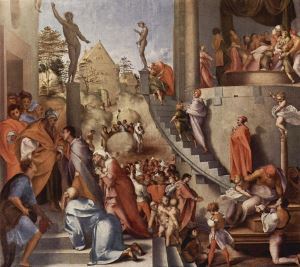
Pontormo also made a trip to Rome to study Michelangelo's works, which informed his own style's emphasis on dynamic movement. By 1515, he had begun to develop his Mannerist style as seen in his Joseph in Egypt (1515-1518) with its creation of an intricate but non-naturalistic space, where crowds clothed in swirling colorful robes mill about, their figures in exaggerated poses and proportions. Pontormo, also a noted teacher, became a lifelong mentor to Bronzino, the leading Mannerist of the next generation.
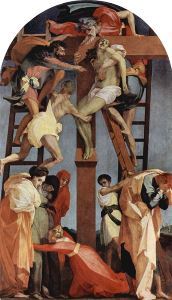
Rosso's first noted work, Deposition (1521), also showed a radical departure from Renaissance proportion and harmony in favor of a Mannerist treatment of both pictorial space and the human figure. He was further influenced by Michelangelo's Sistine Chapel ceiling (1508-1512) upon moving to Rome, where the frescos and the figures painted on the surrounding pediments combined to create a singular effect. Rosso went on to lead the First School of Fontainebleau, which influenced the development of Northern Mannerism.
High Mannerism
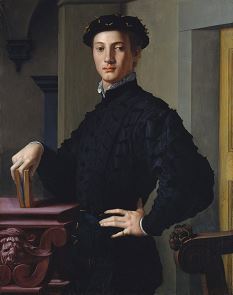
High Mannerism has often been described as a courtly style, its works produced primarily for the powerful rulers of the era and reflecting their aristocratic lifestyles and attitudes. The works of Giambologna exemplified High Mannerism in sculpture, while the works of Agnolo di Cosimo di Mariano, known simply as Bronzino, exemplified the style in painting. Bronzino's refined execution, intellectual sophistication, and his figurative treatment that emphasized elongated limbs and a sense of cold detachment personified the Medici court. In 1539 Bronzino was commissioned by Cosimo I de' Medici to design the lavish decorations for the Duke's marriage to Eleanora di Toledo. Subsequently he became Cosimo I's official court painter, a position he held for the rest of his life. He became a leading portraitist of the aristocracy as seen in his Portrait of Lucrezia Panciatichi (c. 1545), but was most famous, perhaps, for his icy, complex treatment of allegorical erotic subjects as in Venus, Cupid, Folly and Time (c. 1545).
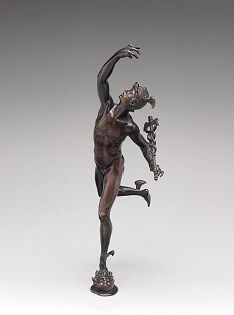
Though born in Flanders, Giambologna studied in Rome where he also considered Michelangelo a great influence. In 1563 he was appointed to the Accademia delle Arti del Disegno, which Cosimo I had just founded in Florence, and became an official artist of the Medici court. He was even forbidden to leave Florence, as the Medici feared he might be lured away by another courtly patron. Working in marble, Giambologna created noted works like Samson Defeating a Philistine (1562) that were meant to impart a political message emphasizing the power of the Medici. He became equally renowned for his bronzes, most of them reproducing his larger works, which were in demand throughout Europe.
Mannerism: Concepts, Styles, and Trends
Although Mannerism was noted for a distinctly courtly style, it was also widely adapted by artists in different geographical locations to the traditional subjects and motifs of a particular area. Identified by the general term Northern Mannerism, it included the noted centers of the School of Fontainebleau in France, Elizabethan and Jacobean court painting in England, the court of the Holy Roman Emperor Rudolf II in Prague, and the Netherlandish cities of Antwerp and Utrecht.
France: School of Fontainebleau (1530-1630)
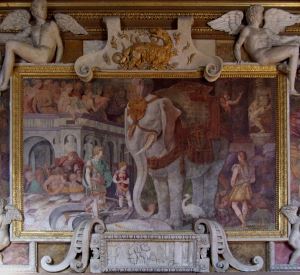
In 1530 the King of France, Francis I, an avid art patron with an enthusiasm for the Italian Renaissance, invited Rosso Fiorentino to the French court. Seizing the opportunity after losing everything in the 1527 Sack of Rome, Rosso moved to Fontainebleau where he resided for the rest of his life. He became the leader of the First School of Fontainebleau in 1530 and developed a distinctive court style. French Mannerism was known for its interiors where paintings, furniture, decorative, and architectural elements created a highly stylized unity. Rosso pioneered the use of large stucco reliefs to be used as frames for inset paintings. They oftentimes bore images of nude nymphs or clumps of fruit and influenced the use of ornamentation throughout Europe. At the same time, his paintings were widely copied and influential to other French artists.
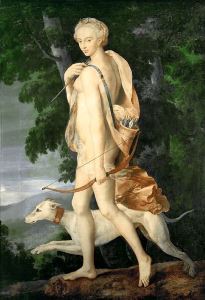
In painting, the patronage of Francis I led to an emphasis on mythological and allegorical subjects with an erotic theme. Rosso led the development alongside Italian Mannerists Francesco Primaticcio and Niccolò dell'Abbate, who were invited to the court in the 1540s. Dell'Abbate was particularly known for his mythological paintings, like the Rape of Proserpine (1552-1570), which combined the nude and landscape genres that had been popularized by The Venetian School. Primaticcio created tapestry designs on similar topics, as well as extensive theatrical and ceremonial productions for the court, though much of that work has been lost. Certain motifs, like depictions of the Roman goddess Diana, personified the French king's love for ideal feminine beauty and became so standardized that they were widely produced by the School's numerous anonymous artists.
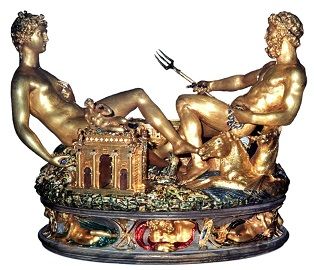
Francis I also commissioned a number of noted works, of which the most famous is Benvenuto Cellini's Salt Cellar (1543). Originally the work was commissioned by Cardinal Ippolito d'Este, who declined the project but presented the model to Francis I. The King was so impressed that he ordered the work to be made in gold. This groundbreaking artistic treatment of an otherwise common household item depicted a goddess representing the earth and a god representing the sea with their legs entwined. It exemplified the wealth, power, and hedonistic lifestyle of the court.
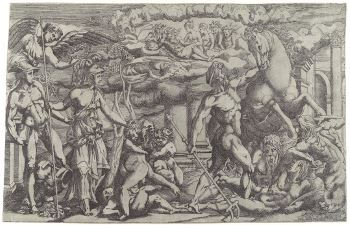
As the School was also known for its printmaking, most of its artworks and designs were disseminated in prints that reached a wide audience throughout Europe. As a result, French artists like Jean Cousin the Elder and sculptors like Germain Pilon adopted the Mannerist style, and the Second School of Fontainebleau, which followed after the deaths of Rosso and Primaticcio, and was headed by the French Toussaint Dubreuil and the Flemish Ambroise Dubois.
Elizabethan and Jacobean Court Painting (1558-1625)
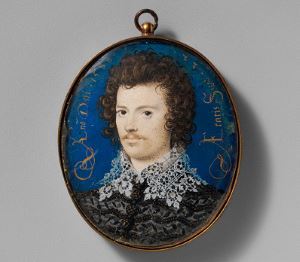
French Mannerism also influenced British court painting during the reigns of Queen Elizabeth I, and her successor James I, primarily by its emphasis on elegant and stylized portraiture. Some portraitists specialized in miniature portraits, a genre of intimate mementos, like Nicholas Hilliard as seen in his Portrait of a Young Man, Probably Robert Devereux (1566-1601), Second Earl of Essex (1588), depicting a particular favorite of the Queen. Other artists like Robert Peake the Elder and Marcus Gheeaerts the Younger were known for full scale portraits, as seen in the Flemish Gheeraerts the Younger's Queen Elizabeth I, the Ditchley Portrait (c. 1592).
Prague and Rudolf II (1576-1612)
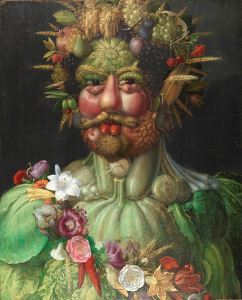
The patronage of Holy Roman Emperor Rudolf II has been described by art historian Martin Bull, as "an explosion of mythological imagery...that had not been seen since Fontainebleau." Rudolf was particularly interested in nude mythological scenes and depictions of Hercules, with whom he identified. The court style that developed in Prague both propagandized for the Emperor and, by depicting mythological subject matter, avoided the controversy surrounding religious imagery. A number of noted artists worked on commissions for the court, including Giambologna in Florence and Paolo Veronese in Venice. Rudolf patronized other leading artists of the day including Hans von Aachen, Giuseppe Arcimboldo, Roelandt Savery, Adrian de Vries, and Aegidius Sadeler. Rudolf's collection and influence became so noted that the term "Rudolfine Mannerism" was developed to describe the style he favored.
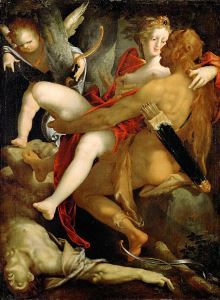
In Prague, the court painter Bartholomeus Spranger led Mannerism. His training reflected the truly international flavor of court Mannerism, as he was born and first trained in Antwerp, but subsequently widely influenced by both the Northern European and the Italian Renaissance, and particularly by the Roman Mannerists. His large paintings were often mythological scenes, combining a bawdy treatment of the nude with an artistic facility that emphasized lavish decorative effects. Prints of his work were disseminated throughout Europe and had a noted impact on the development of Mannerism in the Netherlands.
Mannerism in The Netherlands (1580s-1620)
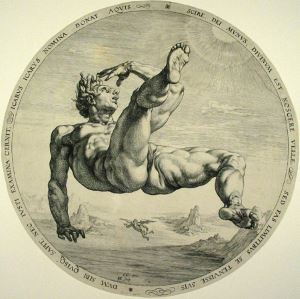
Mannerism in the Netherlands was informed by the Northern European tradition of print making, of which Hendrick Goltz became a leading force. He innovated new etching techniques including the "dot and lozenge" method. The method was innovative for its process in which an artist would place dots within a grid of spaces in a lozenge (or container meant to hold a familiar shape like a body muscle or being in the midst of animation), meant to contain an image, and purposely leave dots out of other areas within the grid making finer tonal gradations visibly possible. Another technique of Goltz was the "swelling line" where the artist would create lines of varying width with his burin, an engraving tool, to manipulate the viewer's final perception of depth. He created hundreds of prints, some of the most notable illustrating mythological and allegorical subjects, like his Icarus (1588), and also a number of prints after the drawings or paintings of Bartholomeus Spranger. Spranger also influenced Goltzius van Mander, Cornelis van Haarlem, and the group of artists known as the Haarlem Mannerists.
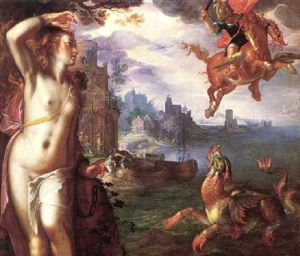
Other artists in the Netherlands were primarily influenced by the Italian Mannerists, as seen in the works of Joachim Wtewael, after his sojourn in Italy in the 1580s. He combined mythological subjects with a traditional Northern European emphasis on landscape and symbolic detail. His approach became the leading trend among the artists centered in Utrecht, particularly as seen in the works of Abraham Bloemaert.
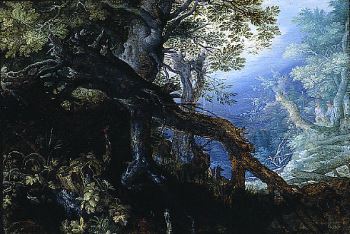
In addition, artists of the Netherlands also adapted the Mannerist style to traditional Northern European subjects when Mattijs, Paul Bril, Hans Rottenhammer, and Adam Elsheimer became noted for their landscape panoramas. Other artists like Albrecht Altdorfer, and Gillis van Coninxloo painted what they called "pure landscapes," usually depicting a dense forest in close-up fashion. This approach influenced subsequent artists like Altdorfer's student Roelandt Savery, whose Forest with deer (1608-1610) is almost modern in its expressionistic effect.
Architecture
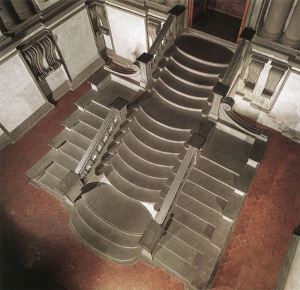
The two most famous Mannerist architects were Michelangelo and Giulio Romano. Michelangelo's most noted design was the Laurentian Library (1523-1568), which he began in 1523 after receiving a commission from Pope Clement VII, a member of the Medici family. The library's vestibule centered upon the staircase that radically combined elliptical shapes for the three bottom steps, quadrangular shapes for the outer step, and convex shapes for the central steps to create a dynamic vertical movement into the upper reading room. The Mannerist effect was further emphasized by wave-like decorative motifs below pairs of ascending columns. Additionally Michelangelo's development of "the colossal order," or "giant order," using pilasters that extended for two or more stories was also influential, as seen in his design for the Palazzo dei Conservatori (mid-16th century).
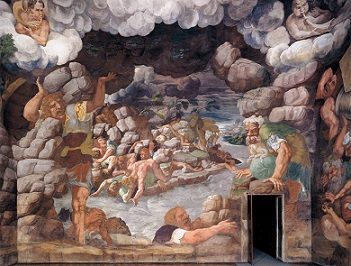
Giulio Romano's Palazzo del Te (1524-1534) was a tour de force of Mannerist architecture and made him famous. Envisioning a kind of pleasure palace, Federico Gonzaga commissioned the design for his familial estate where he raised horses. A square block with a central court, the Palazzo del Te employed false doors and windows, dramatic juxtapositions, as seen in the four different facades in the interior courtyard, and the artist's frescoes. One room was devoted to erotic mythological scenes, another to life-sized depictions of Gonzaga's horses, and the third, the famous Sala dei Giganti, showed giants trying to conquer Mount Olympus in a scene painted from floor to ceiling with a trompe l'oeil effect. As art historians Marvin Trachtenberg and Isabelle Hyman wrote Giulio's "strange, chimerical imagination was most dramatically unleashed in his illusionistic fresco paintings...but the architecture, too, is filled with complicated and unexpected effects."
Later Developments - After Mannerism
Mannerism began to decline around 1600 as the noted artist Caravaggio, dubbed "the father of the Baroque," pioneered a revolutionary approach that combined chiaroscuro and tenebrism, both techniques emphasizing the play of dark and light, with a new realism in dramatic scenes. By 1620, the Baroque period dominated, though the movement's emphasis on dramatic action and intensely emotional scenes can be seen as evolving from Mannerist treatments. In the decorative arts, the Mannerist influence was to continue into the mid-1600s, particularly in the courts of Europe.
The Mannerists influenced the subsequent generation of artists, as Giambologna's students Adriaen de Vries, Pietro Puget, and Pietro Francavilla continued to promote his style in Northern Europe. More importantly, Giambologna's works had a noted influence on Bernini and Alessandro Algari, the leading sculptors of the Baroque era. Cellini's work influenced Antonio Canova, Feodosy Fyodorovich Shchedrin, and, in the 20th century, Salvador Dalí. But, in general, Mannerism fell out of favor, as did many of its leading artists, in the following centuries and was generally seen as a period of decline and decadence following the High Renaissance.
Generally forgotten (except in Spain), the Spanish Renaissance and Mannerist artist El Greco was rediscovered in the 1800s by French artists such as Eugène Delacroix and Édouard Manet. Paul Cézanne went further and painted his own version of El Greco's Lady in a Fur Wrap (1882). His work later became a primary influence upon Pablo Picasso and the development of Cubism, as well as influencing the development of Expressionism in the works of Beckmann, Macke, Kokoschka, Hofer, Steinhardt, and Korteweg. He also influenced Soutine and Chagall, as well as the Surrealists Masson and Domínguez. Noted Spanish artists Ignacio Zuloaga, Santiago Rusiñol, and Joaquín Sorolla drew upon his work, as did the Mexican artists Rivera and Orozco. In the United States, Thomas Hart Benton, Jackson Pollock, and Roberto Matta referenced his work.
Bronzino's work was 'rediscovered' as well, by the Neoclassical Jacques-Louis David, and then by the 20th century artists such as Picasso, Matisse, de Chirico, and Frida Kahlo. Noted writers Marcel Proust, William Somerset Maugham, and Iris Murdoch referenced his work. His work has appealed to a variety of contemporary artists from Yasuko Aoike's manga From Eroica with Love (1976-2010) to Lina Wertmüller's film Seven Beauties (1975) and to photographer Christian Tagliavini's portrait series 1503 (2010).
Mannerist architecture influenced Baroque architecture and, subsequently, the Neo-Palladian movement and Beaux-Arts architecture. The style also influenced the noted 20th century architect Robert Venturi who revived the term, writing, "Mannerism for architecture of our time that...breaks the conventional order to accommodate complexity and contradiction." The importance and continued evaluation of Mannerism through a contemporary lens continues as seen in Peter Greenaway's 2009 multimedia vision of Paolo Veronese's work, and in 2010 major exhibition of Jacopo Bassano's oeuvre.
Useful Resources on Mannerism
-
![Restoring Genius: The Art of Agnolo Bronzino]() 2k viewsRestoring Genius: The Art of Agnolo BronzinoDCDMediaGroup
2k viewsRestoring Genius: The Art of Agnolo BronzinoDCDMediaGroup -
![El Greco: Mystic under a blazing sun]() 0 viewsEl Greco: Mystic under a blazing sunOur PickKultur Films
0 viewsEl Greco: Mystic under a blazing sunOur PickKultur Films -
![The Visitation by Pontormo]() 13k viewsThe Visitation by PontormoLdm News
13k viewsThe Visitation by PontormoLdm News -
![Portrait of a Man by Parmigianino]() 1k viewsPortrait of a Man by ParmigianinoClarkArtInstitute
1k viewsPortrait of a Man by ParmigianinoClarkArtInstitute
-
![Behind the Scenes of Bronzino's Double Portrait of Eleonora di Toledo and Giovanni de' Medici]() 19k viewsBehind the Scenes of Bronzino's Double Portrait of Eleonora di Toledo and Giovanni de' MediciOur PickTalk by Sheila Barker / The Met
19k viewsBehind the Scenes of Bronzino's Double Portrait of Eleonora di Toledo and Giovanni de' MediciOur PickTalk by Sheila Barker / The Met -
![Among Rare Men: Bronzino and Homoerotic Culture at the Medici Court]() 170k viewsAmong Rare Men: Bronzino and Homoerotic Culture at the Medici CourtTalk by Lisa Kaborycha / The Met
170k viewsAmong Rare Men: Bronzino and Homoerotic Culture at the Medici CourtTalk by Lisa Kaborycha / The Met -
![Great Masters with Tim Marlowe: El Greco]() 0 viewsGreat Masters with Tim Marlowe: El GrecoOur Pick
0 viewsGreat Masters with Tim Marlowe: El GrecoOur Pick -
![El Greco with Aleta McGhee of the SMU Meadows Museum]() 5k viewsEl Greco with Aleta McGhee of the SMU Meadows MuseumAllenCityTV
5k viewsEl Greco with Aleta McGhee of the SMU Meadows MuseumAllenCityTV -
![El Greco: Art and Spirituality of the Spanish Renaissance]() 4k viewsEl Greco: Art and Spirituality of the Spanish RenaissanceTalk by Professor Peter Tyler
4k viewsEl Greco: Art and Spirituality of the Spanish RenaissanceTalk by Professor Peter Tyler -
![Colin B. Bailey: Jacopo Bassano, "The Flight into Egypt"]() 5k viewsColin B. Bailey: Jacopo Bassano, "The Flight into Egypt"Our PickThe Frick / Talk by Colin B. Bailey and Peter Jay Sharp
5k viewsColin B. Bailey: Jacopo Bassano, "The Flight into Egypt"Our PickThe Frick / Talk by Colin B. Bailey and Peter Jay Sharp -
![The Poetry of Parmigianino's "Schiava Turca"]() 7k viewsThe Poetry of Parmigianino's "Schiava Turca"Talk by Aimee Ng
7k viewsThe Poetry of Parmigianino's "Schiava Turca"Talk by Aimee Ng -
![The Handwriting of Artists and the Dating of Their Drawings: The Case of Parmigianino]() 22k viewsThe Handwriting of Artists and the Dating of Their Drawings: The Case of ParmigianinoTalk by David Ekserdjian / MET
22k viewsThe Handwriting of Artists and the Dating of Their Drawings: The Case of ParmigianinoTalk by David Ekserdjian / MET -
![Gambologna's The Rape of the Sabine Women]() 48k viewsGambologna's The Rape of the Sabine WomenLdM News
48k viewsGambologna's The Rape of the Sabine WomenLdM News - Gallery Talk: A Bronze Group of the Rape of a Sabine by GiambolognaDonald Johnson / Christies
